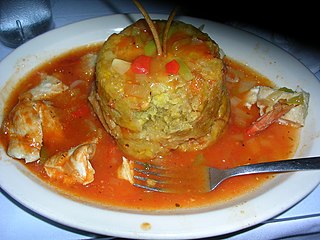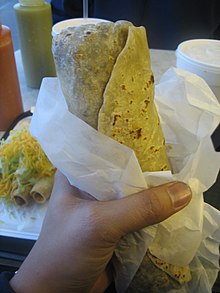
Caribbean cuisine is a fusion of West African, Creole, Amerindian, European, Latin American, Indian/South Asian, Chinese, North American, and Middle Eastern cuisines. These traditions were brought from many countries when they moved to the Caribbean. In addition, the population has created styles that are unique to the region.

Puerto Ricans, most commonly known as Boricuas, but also occasionally referred to as Borinqueños,Borincanos, or Puertorros, are an ethnic group native to the Caribbean archipelago of Puerto Rico, and a nation identified with the Commonwealth of Puerto Rico through ancestry, culture, or history. Puerto Ricans are predominately a tri-racial, Spanish-speaking, Christian society, descending in varying degrees from Indigenous Taíno natives, Southwestern European colonists, and West and Central African slaves, freedmen, and free Blacks. As citizens of a U.S. territory, Puerto Ricans have automatic birthright American citizenship, and are considerably influenced by American culture. The population of Puerto Ricans is between 9 and 10 million worldwide, with the overwhelming majority residing in Puerto Rico and mainland United States.

Puerto Rican cuisine consists of the cooking style and traditional dishes original to Puerto Rico. It has been primarily a fusion influenced by the ancestors of the Puerto Rican people: the indigenous Taínos, Spanish Criollos and sub-Saharan African slaves. As a territory of the United States, the culinary scene of Puerto Rico has also been moderately influenced by American cuisine.

The region known as Hispanic America and historically as Spanish America is all the Spanish-speaking countries of the Americas. In all of these countries, Spanish is the main language - sometimes sharing official status with one or more indigenous languages or English, and Roman Catholicism is the predominant religion.

Latin American cuisine is the typical foods, beverages, and cooking styles common to many of the countries and cultures in Latin America. Latin America is a highly racially, ethnically, and geographically diverse with varying cuisines. Some items typical of Latin American cuisine include maize-based dishes arepas, empanadas, pupusas, tacos, tamales, tortillas and various salsas and other condiments. Sofrito, a culinary term that originally referred to a specific combination of sautéed or braised aromatics, exists in Latin American cuisine. It refers to a sauce of tomatoes, roasted bell peppers, garlic, onions and herbs. Rice, corn, pasta, bread, plantain, potato, yucca, and beans are also staples in Latin American cuisine.

Fufu is a pounded meal found in West African cuisine. It is a Twi word that originates from the Akans in Ghana. The word has been expanded to include several variations of the pounded meal found in other African countries including Sierra Leone, Guinea, Liberia, Cote D'Ivoire, Burkina Faso, Benin, Togo, Nigeria, Cameroon, the Democratic Republic of Congo, the Central African Republic, the Republic of Congo, Angola and Gabon. It also includes variations in the Greater Antilles and Central America, where African culinary influence is high.

The cuisine of New York City comprises many cuisines belonging to various ethnic groups that have entered the United States through the city. Almost all ethnic cuisines are well represented in New York, both within and outside the various ethnic neighborhoods.

Creole cuisine is a cuisine style born in colonial times, from the fusion between African, European and pre-Columbian American traditions. Creole is a term that refers to those of European origin who were born in the New World and have adapted to it.

Mofongo is a dish from Puerto Rico with plantains as its main ingredient. Plantains are picked green, cut into pieces and typically fried but can be boiled or roasted, then mashed with salt, garlic, broth, and olive oil in a wooden pilón. The goal is to produce a tight ball of mashed plantains that will absorb the attending condiments and have either pork cracklings (chicharrón) or bits of bacon inside. It is traditionally served with fried meat and chicken broth soup. Particular flavors result from variations that include vegetables, chicken, shrimp, beef, or octopus packed inside or around the plantain orb.

The culture of Puerto Rico is the result of a number of internal and indigenous influences, both past and present. Modern cultural manifestations showcase the island's rich history and help create an identity that is uniquely Puerto Rican - Taíno, Spanish, African, and North American.

The Spanish West Indies, Spanish Caribbean or the Spanish Antilles were Spanish territories in the Caribbean. In terms of governance of the Spanish Empire, The Indies was the designation for all its overseas territories and was overseen by the Council of the Indies, founded in 1524 and based in Spain. When the Crown established the Viceroyalty of New Spain in 1535, the islands of the Caribbean came under its jurisdiction.

The Caribbean is a subregion of the Americas that includes the Caribbean Sea and its islands, some of which are surrounded by the Caribbean Sea and some of which border both the Caribbean Sea and the North Atlantic Ocean; the nearby coastal areas on the mainland are sometimes also included in the region. The region is south-east of the Gulf of Mexico and Northern America, east of Central America, and north of South America.

Tostones are twice-fried plantain slices commonly found in Latin American cuisine and Caribbean cuisine. Most commonly known as tostones in Jamaica, Puerto Rico, Mexico, Nicaragua, Cuba, Dominican Republic, Honduras and Venezuela, they are also known as tachinos or chatinos (Cuba), bannann peze (Haiti), patacones and, sometimes, patacón pisao in Colombia.

The cuisine of the Americas is made up of a variety of food preparation styles.
The culture of North America refers to the arts and other manifestations of human activities and achievements from the continent of North America. Cultures of North America reflect not only that of the continent's indigenous peoples but those cultures that followed European colonisation as well.

The term Latin America and the Caribbean (LAC) is an English-language acronym referring to the Latin American and the Caribbean region. The term LAC covers an extensive region, extending from The Bahamas and Mexico to Argentina and Chile. The region has over 670,230,000 people as of 2016, and spanned for 21,951,000 square kilometres (8,475,000 sq mi).
















